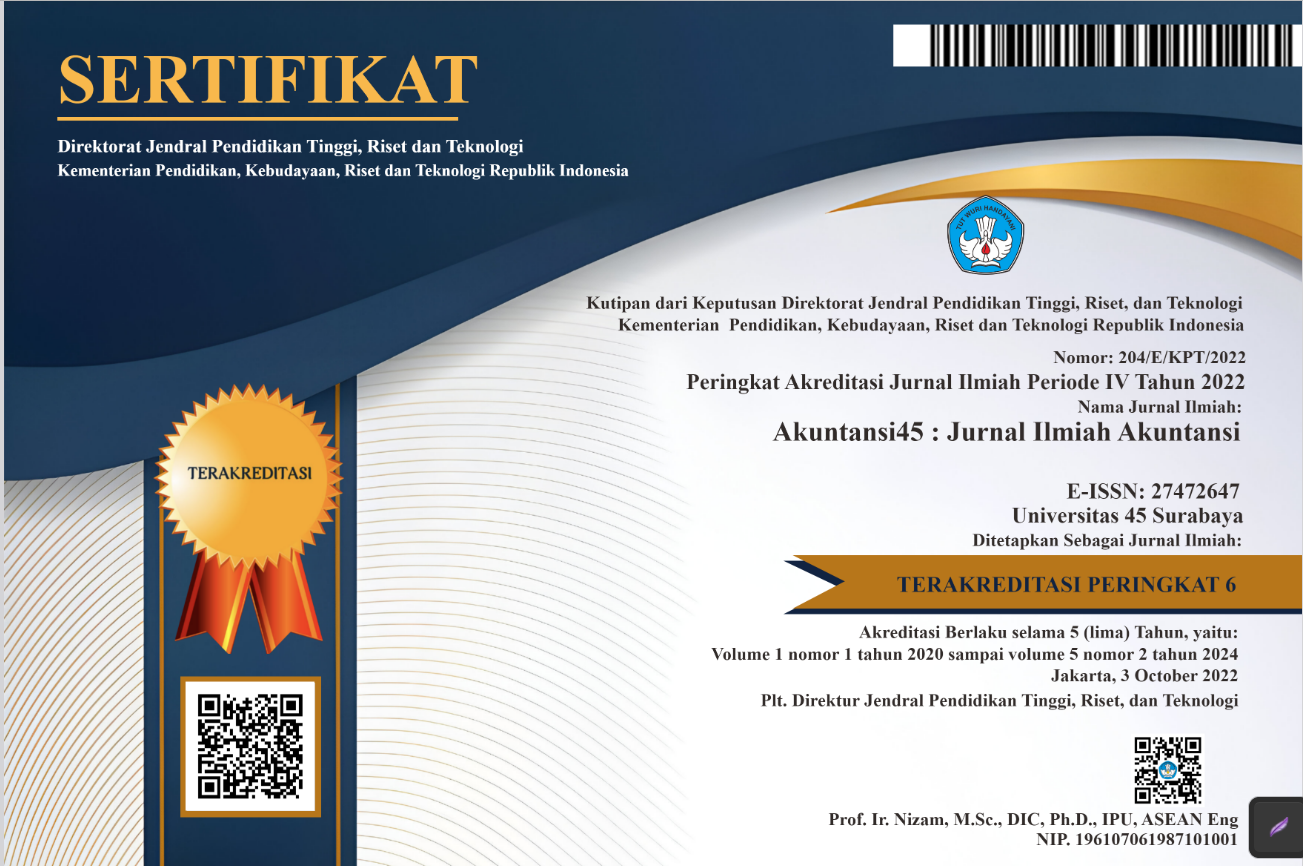Pengaruh Bisnis Analitik dan Bisnis Intelijen terhadap Optimasi Operasional Sehingga Meningkatkan Kinerja Keuangan Distributor Alat Kesehatan di Indonesia
DOI:
https://doi.org/10.30640/akuntansi45.v5i2.3476Keywords:
Business Analytics, Business Intelligence, Operational Optimization, Financial PerformanceAbstract
The purpose of this study is to prove how business analytics (BA) and business intelligence (BI) implementation affects Indonesian medical equipment distributors' financial performance and operational optimization. Sixty representatives of medical equipment distribution enterprises with transaction values over one billion rupiah participated in an online questioner that was used to collect data. The analysis's findings show that these organizations' financial performance is significantly and favourably impacted by the application of business analytics, operational optimization, and intelligence. Businesses may improve competitiveness, streamline operations, and make better decisions by implementing business analytics and intelligence. Furthermore, the financial performance is greatly enhanced by the operational optimization that comes from the application of BI and BA. The created study model incorporates Information Processing Theory (IPT) and shows how corporate management practices are impacted by the success of BI implementation, which in turn influences organizational process effectiveness. Performance planning and measurement are directly impacted by BA techniques as well. This study has significant ramifications for business professionals that use business analytics and intelligence as strategic instruments to improve their organizations' financial performance, especially in the medical equipment sector. According to the results, businesses who use BI and BA may optimize their processes more successfully, which improves their financial performance. In summary, this study emphasizes how crucial it is to include BI and BA technology into business operations and strategic decision-making.
References
Abusweilem, M. A., & Abualoush, S. (2019). The impact of knowledge management process and business intelligence on organizational performance. Management Science Letters, 9(12), 2143–2156. https://doi.org/10.5267/j.msl.2019.6.020
Alnoukari, M., & Hanano, A. (n.d.). Integration of business intelligence with corporate strategic management. https://ojs.hh.se/
An integrated model for determining business intelligence systems adoption and post-adoption benefits in banking sector. (2016). Journal of Administrative and Business Studies, 2(2). https://doi.org/10.20474/jabs-2.2.4
Appelbaum, D., Kogan, A., Vasarhelyi, M., & Yan, Z. (2017). Impact of business analytics and enterprise systems on managerial accounting. International Journal of Accounting Information Systems, 25, 29–44. https://doi.org/10.1016/j.accinf.2017.03.003
Aras, G., Aybars, A., & Kutlu, O. (2010). Managing corporate performance: Investigating the relationship between corporate social responsibility and financial performance in emerging markets. International Journal of Productivity and Performance Management, 59(3), 229–254. https://doi.org/10.1108/17410401011023573
Aydiner, A. S., Tatoglu, E., Bayraktar, E., Zaim, S., & Delen, D. (2019). Business analytics and firm performance: The mediating role of business process performance. Journal of Business Research, 96, 228–237. https://doi.org/10.1016/j.jbusres.2018.11.028
Bhatiasevi, V., & Naglis, M. (2020). Elucidating the determinants of business intelligence adoption and organizational performance. Information Development, 36(1), 78–96. https://doi.org/10.1177/0266666918811394
Cao, L. (2020). AI in Finance: A Review. https://doi.org/
Caserio, C., & Trucco, S. (2018). Business intelligence systems. In Contributions to Management Science (pp. 43–73). Springer. https://doi.org/10.1007/978-3-319-77679-8_3
Chen, Y., & Lin, Z. (2021). Business Intelligence Capabilities and Firm Performance: A Study in China. International Journal of Information Management, 57. https://doi.org/10.1016/j.ijinfomgt.2020.102232
Cody, W. F., Kreulen, J. T., Krishna, V., & Spangler, W. S. (2002). The integration of business intelligence and knowledge management.
Dhanya, R., Paul, I. R., Akula, S. S., Sivakumar, M., & Nair, J. J. (2020). F-test feature selection in Stacking ensemble model for breast cancer prediction. Procedia Computer Science, 171, 1561–1570. https://doi.org/10.1016/j.procs.2020.04.167
Duan, Y., Cao, G., & Edwards, J. S. (2020). Understanding the impact of business analytics on innovation. European Journal of Operational Research, 281(3), 673–686. https://doi.org/10.1016/j.ejor.2018.06.021
Elbashir, M. Z., Collier, P. A., & Davern, M. J. (2008). Measuring the effects of business intelligence systems: The relationship between business process and organizational performance. International Journal of Accounting Information Systems, 9(3), 135–153. https://doi.org/10.1016/j.accinf.2008.03.001
Elbashir, M. Z., Sutton, S. G., Mahama, H., & Arnold, V. (2021). Unravelling the integrated information systems and management control paradox: enhancing dynamic capability through business intelligence. Accounting and Finance, 61(S1), 1775–1814. https://doi.org/10.1111/acfi.12644
Ferranti, J. M., Langman, M. K., Tanaka, D., McCall, J., & Ahmad, A. (2010). Bridging the gap: Leveraging business intelligence tools in support of patient safety and financial effectiveness. Journal of the American Medical Informatics Association, 17(2), 136–143. https://doi.org/10.1136/jamia.2009.002220
Ghazanfari, M., Jafari, M., & Rouhani, S. (2011). A tool to evaluate the business intelligence of enterprise systems. Scientia Iranica, 18(6), 1579–1590. https://doi.org/10.1016/j.scient.2011.11.011
Hani Zulkifli Abai, N., Yahaya, J., Deraman, A., Razak Hamdan, A., Mansor, Z., & Yah Jusoh, Y. (2019). Integrating Business Intelligence and Analytics in Managing Public Sector Performance: An Empirical Study. 9(1).
Hasanaj, P., & Kuqi, B. (2019). Analysis of Financial Statements. Humanities and Social Science Research, 2(2), p17. https://doi.org/10.30560/hssr.v2n2p17
Herzog, C., Hook, D., & Konkiel, S. (2020). Dimensions: Bringing down barriers between scientometricians and data. Quantitative Science Studies, 1(1), 387–395. https://doi.org/10.1162/qss_a_00020
Ibrahim, J., Bhatti, Z., & Waqas, A. (2014). Business Intelligence as a Knowledge Management Tool in Providing Financial Consultancy Services. American Journal of Information Systems, 2(2), 26–32. https://doi.org/10.12691/ajis-2-2-1
Jayakrishnan, M., Mohamad, A. K., Azmi, F. R., & Abdullah, A. (2018). Implementation of business intelligence framework for Malaysian halal food manufacturing industry towards initiate strategic financial performance management. Management Science Letters, 8(10), 1059–1076. https://doi.org/10.5267/j.msl.2018.7.007
Kaushal, N. K., Chang, K., Lee, J. G., & Muthusamy, V. R. (2014). Using efficiency analysis and targeted intervention to improve operational performance and achieve cost savings in the endoscopy center. Gastrointestinal Endoscopy, 79(4), 637–645. https://doi.org/10.1016/j.gie.2013.10.037
Kédagni, D., & Mourifié, I. (2020). Generalized instrumental inequalities: testing the instrumental variable independence assumption. Biometrika, 107(3), 661–675. https://doi.org/10.1093/biomet/asaa003
Kersten, Martin., & ACM Digital Library. (2009). Proceedings of the 12th International Conference on Extending Database Technology Advances in Database Technology. ACM.
Khan, M. A., Saqib, S., Alyas, T., Ur Rehman, A., Saeed, Y., Zeb, A., Zareei, M., & Mohamed, E. M. (2020). Effective Demand Forecasting Model Using Business Intelligence Empowered with Machine Learning. IEEE Access, 8, 116013–116023. https://doi.org/10.1109/ACCESS.2020.3003790
Khan, R. A., & Quadri, S. M. K. (2012). BUSINESS INTELLIGENCE: AN INTEGRATED APPROACH. In Business Intelligence Journal (Vol. 5, Issue 1).
Khan, R. A., & Quadri, S. M. K. (2014). Business Intelligence: An Integrated Approach. In International Journal of Management and Innovation (Vol. 6).
Khedr, A., Kholeif, S., & Saad, F. (2017). An Integrated Business Intelligence Framework for Healthcare Analytics. International Journal of Advanced Research in Computer Science and Software Engineering, 7(5), 263–270. https://doi.org/10.23956/ijarcsse/SV7I5/0163
Khemet, B., & Richman, R. (2018). A univariate and multiple linear regression analysis on a national fan (de)Pressurization testing database to predict airtightness in houses. In Building and Environment (Vol. 146, pp. 88–97). Elsevier Ltd. https://doi.org/10.1016/j.buildenv.2018.09.030
Lim, Y. Y., & Teoh, A. P. (2020). Realizing the strategic impact of business intelligence utilization. In Strategic Direction (Vol. 36, Issue 4, pp. 7–9). Emerald Group Holdings Ltd. https://doi.org/10.1108/SD-09-2019-0184
Lussak, A., Abdurachman, E., Gautama, I., & Setiowati, R. (2020). The influence of financial performance and innovation of services and products on the survival of small businesses in food and beverage in the Jakarta city with mediation of operational improvement. Management Science Letters, 10(2), 463–468. https://doi.org/10.5267/j.msl.2019.8.024
Majan College, & Institute of Electrical and Electronics Engineers. (n.d.). Proceedings of MIC 2018, Majan International Conference : Promoting Entrepreneurship & Technological Skills: National Needs, Global Trends : Majan College (University College), Muscat, Oman, 19th March 2018.
Melchert, F., Winter, R., Klesse, M., Melchert, F. ;, Winter, R. ;, & Aligning, ". (2004). Aligning Process Automation and Business Intelligence to Support Corporate Performance Management. http://aisel.aisnet.org/amcis2004/507
Mesaros, P., Carnicky, S., Mandicak, T., Habinakova, M., Mackova, D., & Spisakova, M. (2016). Business Intelligence impact on corporate performance in Slovak enterprises – a case study. Journal of Systems Integration, 7(4), 9–18. https://doi.org/10.20470/jsi.v7i4.267
Mishra, P., Pandey, C. M., Singh, U., Gupta, A., Sahu, C., & Keshri, A. (2019). Descriptive statistics and normality tests for statistical data. Annals of Cardiac Anaesthesia, 22(1), 67–72. https://doi.org/10.4103/aca.ACA_157_18
Moser, A., & Korstjens, I. (2018). Series: Practical guidance to qualitative research. Part 3: Sampling, data collection and analysis. In European Journal of General Practice (Vol. 24, Issue 1, pp. 9–18). Taylor and Francis Ltd. https://doi.org/10.1080/13814788.2017.1375091
Nithya, N., & Kiruthika, R. (2021). Impact of Business Intelligence Adoption on performance of banks: a conceptual framework. Journal of Ambient Intelligence and Humanized Computing, 12(2), 3139–3150. https://doi.org/10.1007/s12652-020-02473-2
Niu, Y., Ying, L., Yang, J., Bao, M., & Sivaparthipan, C. B. (2021). Organizational business intelligence and decision making using big data analytics. Information Processing and Management, 58(6). https://doi.org/10.1016/j.ipm.2021.102725
Nofal, M. I., & Yusof, Z. M. (2013). Integration of Business Intelligence and Enterprise Resource Planning within Organizations. Procedia Technology, 11, 658–665. https://doi.org/10.1016/j.protcy.2013.12.242
Orbay, M., Karamustafaoglu, O., & Miranda, R. (2021). Analysis of the journal impact factor and related bibliometric indicators in education and educational research category. Education for Information, 37(3), 315–336. https://doi.org/10.3233/EFI-200442
Owusu, A. (2017). Business intelligence systems and bank performance in Ghana: The balanced scorecard approach. Cogent Business and Management, 4(1). https://doi.org/10.1080/23311975.2017.1364056
Park, Y. W., & Klabjan, D. (2020). Subset selection for multiple linear regression via optimization. Journal of Global Optimization, 77(3), 543–574. https://doi.org/10.1007/s10898-020-00876-1
Peters, M. D., Wieder, B., Sutton, S. G., & Wakefield, J. (2016). Business intelligence systems use in performance measurement capabilities: Implications for enhanced competitive advantage. International Journal of Accounting Information Systems, 21, 1–17. https://doi.org/10.1016/j.accinf.2016.03.001
Qihai, Z., Tao, H., & Tao, W. (2008). Analysis of Business Intelligence and its derivative - Financial intelligence. Proceedings of the International Symposium on Electronic Commerce and Security, ISECS 2008, 997–1000. https://doi.org/10.1109/ISECS.2008.28
Ramakrishnan, T., Khuntia, J., Kathuria, A., & Saldanha, T. J. V. (2020). An integrated model of business intelligence & analytics capabilities and organizational performance. Communications of the Association for Information Systems, 46, 722–750. https://doi.org/10.17705/1CAIS.04631
Richards, G., Yeoh, W., Chong, A. Y. L., & Popovič, A. (2019). Business Intelligence Effectiveness and Corporate Performance Management: An Empirical Analysis. Journal of Computer Information Systems, 59(2), 188–196. https://doi.org/10.1080/08874417.2017.1334244
Shrestha, N. (2020a). Detecting Multicollinearity in Regression Analysis. American Journal of Applied Mathematics and Statistics, 8(2), 39–42. https://doi.org/10.12691/ajams-8-2-1
Shrestha, N. (2020b). Detecting Multicollinearity in Regression Analysis. American Journal of Applied Mathematics and Statistics, 8(2), 39–42. https://doi.org/10.12691/ajams-8-2-1
Siedlecki, S. L. (2020). Understanding Descriptive Research Designs and Methods. Clinical Nurse Specialist, 34(1), 8–12. https://doi.org/10.1097/NUR.0000000000000493
Suša Vugec, D., Bosilj Vukšić, V., Pejić Bach, M., Jaklič, J., & Indihar Štemberger, M. (2020). Business intelligence and organizational performance: The role of alignment with business process management. Business Process Management Journal, 26(6), 1709–1730. https://doi.org/10.1108/BPMJ-08-2019-0342
Tamang, M. D., Kumar Shukla, V., Anwar, S., & Punhani, R. (2021). Improving Business Intelligence through Machine Learning Algorithms. Proceedings of 2021 2nd International Conference on Intelligent Engineering and Management, ICIEM 2021, 63–68. https://doi.org/10.1109/ICIEM51511.2021.9445344
Tong-On, P., Siripipatthanakul, S., & Phayaphrom, B. (2021). The implementation of business intelligence using data analytics and its effects towards performance in hotel industry in Thailand. In International Journal of Behavioral Analytics (Vol. 1, Issue 2). https://ssrn.com/abstract=3944077
Torres, R., Sidorova, A., & Jones, M. C. (2018). Enabling firm performance through business intelligence and analytics: A dynamic capabilities perspective. Information and Management, 55(7), 822–839. https://doi.org/10.1016/j.im.2018.03.010
Vabalas, A., Gowen, E., Poliakoff, E., & Casson, A. J. (2019). Machine learning algorithm validation with a limited sample size. PLoS ONE, 14(11). https://doi.org/10.1371/journal.pone.0224365
Vukšić, V. B., Bach, M. P., & Popovič, A. (2013). Supporting performance management with business process management and business intelligence: A case analysis of integration and orchestration. International Journal of Information Management, 33(4), 613–619. https://doi.org/10.1016/j.ijinfomgt.2013.03.008
Wahua, L., & Ahlijah, Y. (n.d.). Business intelligence costs and firm performance: evidence from top selected ECOWAS’ banks BUSINESS INTELLIGENCE COSTS AND FIRM PERFORMANCE: EVIDENCE FROM SELECTED TOP ECOWAS’ BANKS. https://www.researchgate.net/publication/341473454
Williams, S., & Williams, N. (n.d.). Six Montgomery Village Ave (Vol. 622).
Xue, W., Li, H., Ali, R., & Ur Rehman, R. (2020). Knowledge mapping of corporate financial performance research: A visual analysis using cite space and ucinet. In Sustainability (Switzerland) (Vol. 12, Issue 9). MDPI. https://doi.org/10.3390/SU12093554
Yahaya, J., Abai, N. H. Z., Deraman, A., & Jusoh, Y. Y. (2019). The implementation of business intelligence and analytics integration for organizational performance management: A case study in public sector. International Journal of Advanced Computer Science and Applications, 10(11), 292–299. https://doi.org/10.14569/IJACSA.2019.0101140
Zafary, F. (n.d.). Implementation of business intelligence considering the role of information systems integration and enterprise resource planning. https://ojs.hh.se/
Zragat, O. M. (2020). The Moderating Role of Business Intelligence in the Impact of Big Data on Financial Reports Quality in Jordanian Telecom Companies. Modern Applied Science, 14(2), 71. https://doi.org/10.5539/mas.v14n2p71
Aziz Sholeh, Abdul et. Al. 2024. Kompensasi Terhadap Motivasi Kerja Karyawan pada PT. Insolent Raya di Surabaya, Journal Of Management and Creative Business Vol. 2 No. 1 Januari 2024, Halaman : 82 - 96
Kristiawati, et al. 2019. Citra Merek Persepsi Harga dan Nilai Pelanggan Terhadap Keputusan Pembelian Pada Mini Market Indomaret Lontar Surabaya. Jurnal Ilmu Ekonomi dan Manajemen (JMM 17) Vol. 6 No. 2, September 2019, Hal. 27- 36.
Salim Gazali et al. 2024. Ikan Nomei, Merdeka Belajar Kampus Merdeka, Halaman : 1 - 98
Downloads
Published
How to Cite
Issue
Section
License
Copyright (c) 2024 AKUNTANSI 45

This work is licensed under a Creative Commons Attribution-ShareAlike 4.0 International License.









